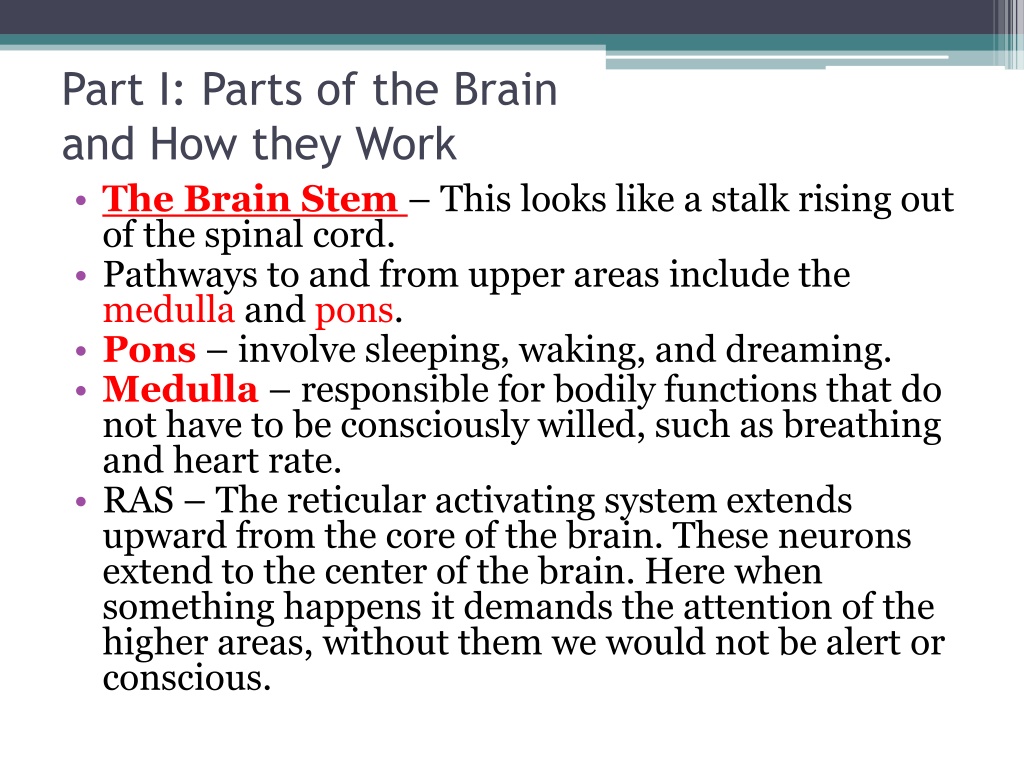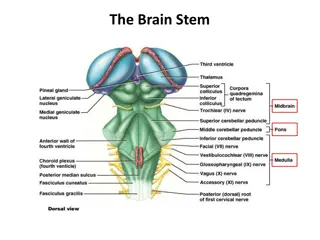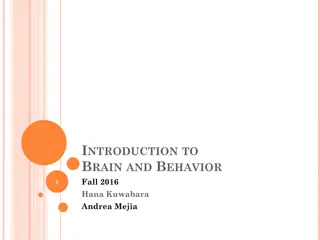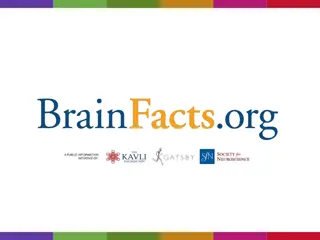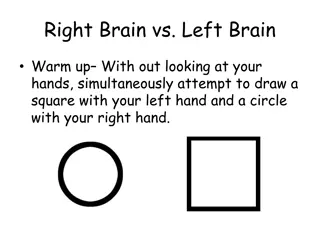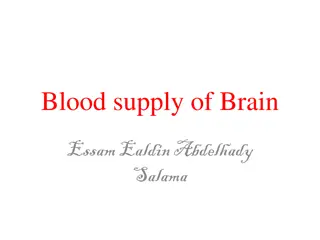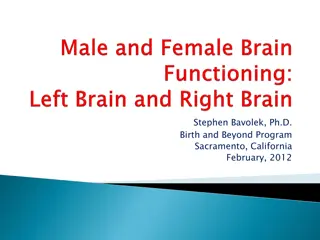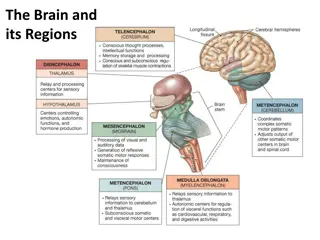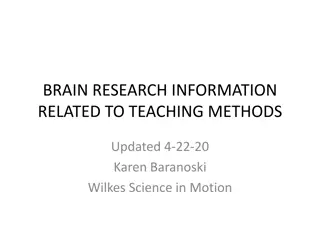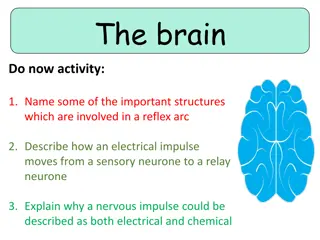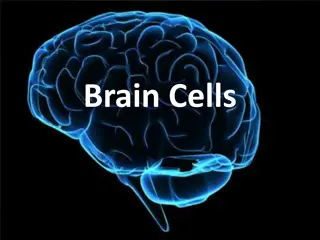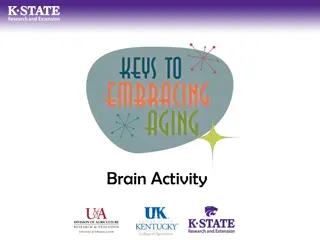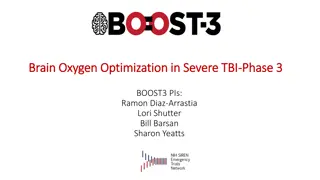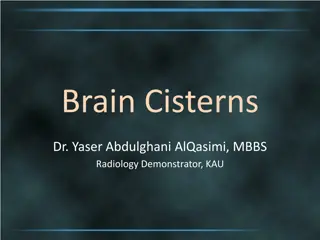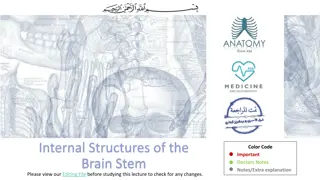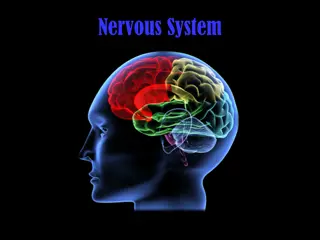Understanding Parts of the Brain and Their Functions
The brain consists of different parts with unique roles. The Brain Stem controls essential functions like breathing, while the Cerebellum aids in balance and muscle coordination. The Thalamus directs sensory messages, the Hypothalamus regulates survival drives, and the Amygdala evaluates emotional responses. The Hippocampus compares sensory information with learned expectations, shaping our perception of the world.
Download Presentation

Please find below an Image/Link to download the presentation.
The content on the website is provided AS IS for your information and personal use only. It may not be sold, licensed, or shared on other websites without obtaining consent from the author. Download presentation by click this link. If you encounter any issues during the download, it is possible that the publisher has removed the file from their server.
E N D
Presentation Transcript
Part I: Parts of the Brain and How they Work The Brain Stem This looks like a stalk rising out of the spinal cord. Pathways to and from upper areas include the medulla and pons. Pons involve sleeping, waking, and dreaming. Medulla responsible for bodily functions that do not have to be consciously willed, such as breathing and heart rate. RAS The reticular activating system extends upward from the core of the brain. These neurons extend to the center of the brain. Here when something happens it demands the attention of the higher areas, without them we would not be alert or conscious.
Parts of the Brain The Cerebellum Also known as the lesser brain, this gives us balance and coordinates the muscles so that movement is smooth and precise. If your cerebellum were damaged you would probably be clumsy and uncoordinated. This part of the brain also is involved in remembering simple skills and acquired reflexes (tying your shoes, juggling a soccer ball). In addition, it also plays a part in complex tasks and analyzing sensory information.
Parts of the Brain The Thalamus Known as the traffic officer of the brain, the Thalamus directs sensory messages that come into the brain to high centers. For example A sunset would send signals directed to vision area, sound signals sends information to the auditory area. The only sense that completely bypasses the thalamus is the sense of smell, which has its own private switching station, the olfactory bulb.
Parts of the Brain They Hypothalamus and the Pituitary Gland Hypo means under. This is involved in drives associated with survival of the individual and species. It regulates body temperature by triggering sweating or shivering, and controls the operations of the atomic nervous system. It also contains the biological clock that controls the body s daily rhythms. Hanging down from the hypothalamus is the pituitary gland. Also known as the master gland because the hormones it secretes effect other endocrine glands by sending hormonal messages out to these glands. TOGETHER THESE MAKE UP THE LIMBIC SYSTEM.
Parts of the Brain The Amygdala (Ancient word for almond) is responsible for evaluating sensory information, quickly determining its emotional importance, and contributing to the initial decision to approach or withdraw from a person or situation. Instantly assesses danger or a threat, mediates anxiety or depression. PET scans find that depressed and anxious patients show increased neural activity in the limbic structure.
Parts of the Brain The Hippocampus (Means seahorse in Latin, named after its shape). This structure compares sensory information with what the brain has learned to expect about the world. When expectations are met, there is no need for neural alarm every time something happens around you. It has also been called the gateway to memory. The Hippocampus enables us to form spatial memories so that we can accurately navigate through our environment. In addition, it also forms new memories to help you identify and create new memories and facts. This information is stored in the cerebral cortex. For examples, when you recall information you remember things like tone, appearance, and location.
Parts of the Brain The Cerebrum Where the higher forms of thinking take place. Divided into two separate halves, or cerebral hemispheres, connected by a large band of fibers called the corpus callosum. In general, the right hemisphere is in charge of the left side of the body and the left hemisphere is in charge of the right side of the body. The two hemispheres also have somewhat different tasks.
Part II: Lobes of the Cerebrum The Cerebral Cortex - A collection of several thin layers of cells covering the cerebrum; it is largely responsible for higher mental functions. Contains both grey and white matter, referring to the types of tissue located here. Some are more grey and some are more white. It is only about 3 millimeters thick, yet it contains three-fourths of all the cells in the human brain. The Cortex has many crevasses and wrinkles, which enable it to contain its billions of neurons without requiring us to have the heads of giants - heads that would be too big to allow us to be born.
Lobes of the Cortex Occipital Lobes are at the lower back part of the brain. They contain the visual cortex, where visual signals are processed. Damaged to the visual cortex can cause impaired visual recognition or even blindness. Parietal Lobes They contain the somatosensory cortex, which receives information about pressure, pain, touch and temperature from all over the body. Parts are also involved in attention and various mental operations. Temporal Lobes are at the sides of the brain, just abbbove the ears, behind the temples. They are involved in memory, perception, and emotion, and they contain the autidory cortex which processes sounds. An area of the left temporal lobe known as Wernicke s area is involved in language comprehension. Frontal Lobes Located toward the front of the brain just under the skull in the area of the forehead. They contain the motor cortex, which issues orders to the 600 muscles in the body that produce voluntary movement. In the left frontal lobe, a region known as Broca s area handles speech production. During short-term memory tasks, areas in the frontal lobes are especially active. The frontal lobes are also involved in emotion and the ability to make plans = think creatively, and take initiative.
